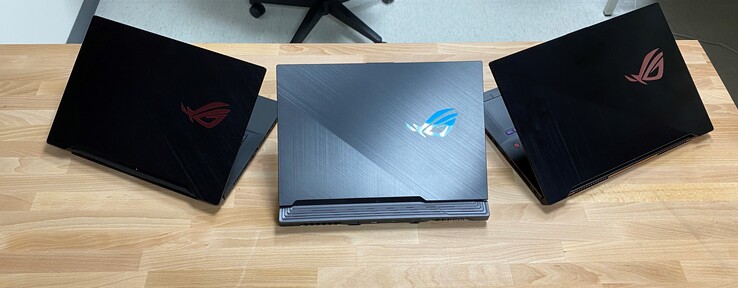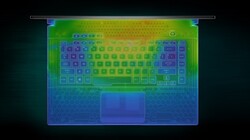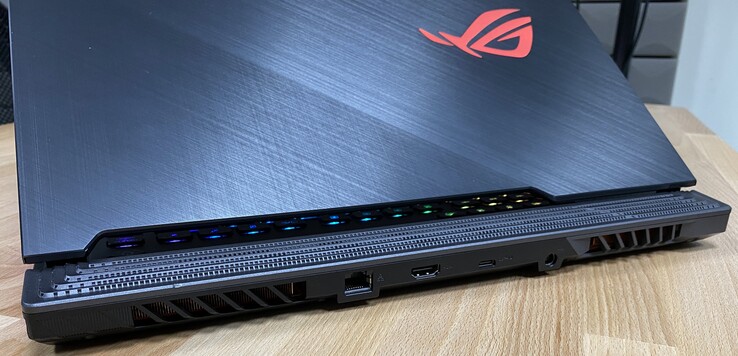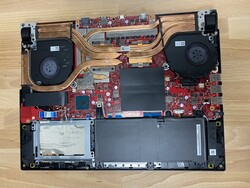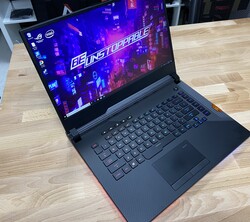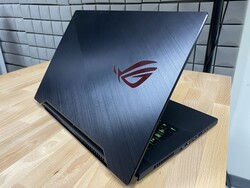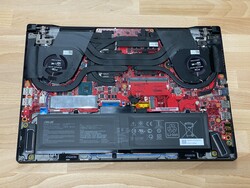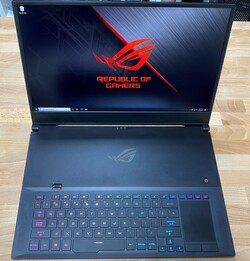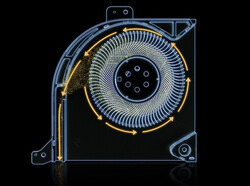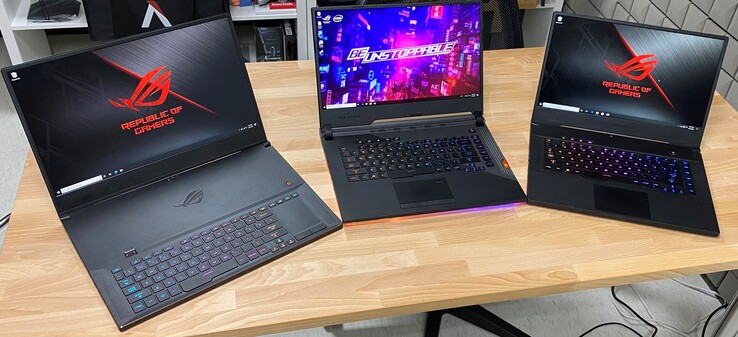How ROG improves gaming performance by up to 20% (Hint: it’s cool.)
To understand the results, you have to understand ROG Boost, the name that ASUS uses to describe the improved GPU performance it derives from greater thermal headroom. Most laptop GPUs use lower clocks and wattages to compensate for the thermal constraints of their chassis. They harness NVIDIA’s GPU Boost technology to increase clock speeds when (closely monitored) thermals allow. Laptop makers have some freedom to define their GPU clock speeds and wattage within the range of specs supported by NVIDIA. ROG Boost ratchets up these specs, pushing the GPU to realize more of its potential and in some cases even surpass stock frequencies.
Innovative cooling designs give ROG Boost the headroom required to achieve higher performance. To see how, let’s look at the engineering behind the laptops we tested.
Intelligent cooling
ROG customizes the cooling for every laptop it makes, tuning for not only the chassis but also the components inside. The attention to detail is apparent in the three 2019 models used for these tests: a 15” Strix SCAR III G531 with a more traditional form factor, an ultra-slim 15” Zephyrus S GX502, and its 17” sibling with a keyboard-forward layout, the Zephyrus S GX701.
The SCAR III resembles a conventional design until you see the extra venting at the back that gives the laptop a futuristic look. A trapezoidal cut puts distance between the screen’s bottom bezel and a stack of perforated ridges running along the back of the machine. This allows cool air to flow in freely from above to augment the main intakes underneath the chassis.
Two 12V ROG n-Blade fans drive air through the system’s heatsinks using a dense array of 83 superthin blades each. To fit so many blades, each one slims down to just 0.25mm thin, which is possible thanks to a resilient liquid crystal polymer. The material is stiff enough to ensure the blades hold up at the high RPMs required for maximum airflow, and the assembly is reinforced by a special ring that helps to maintain blade spacing. ROG has added more blades since it first introduced this fan design, enabling higher airflow to improve system cooling without increasing noise.
The blade density stands out with the bottom panel removed, as do the system’s five heat pipes. Two are wholly dedicated to the GPU, one to the CPU, and a fourth is shared between them. Another wraps around the GPU, cooling its GDDR6 memory and the VRM supplying the processors. The configuration of pipes varies by model and the power requirements of the GPU, though simply comparing numbers and designs across OEMs would be misleading. Not all heatpipes are equally capable of transferring heat. ROG, for example, focuses on efficient thermal exchange, using sintered metal and parallel channels inside its heatpipes to speed transfer between the system’s individual components and their associated heatsinks.
The SCAR III contains three such heatsinks filled with stacks of copper fins. Some of the fins are just 0.1mm thin, or half the thickness of standard designs. Using thinner fins lets ROG increase surface for heat dissipation without taking up more space. They also reduce air resistance, enabling the SCAR’s fans to more efficiently push warm air out of the chassis’s exhaust vents.
ROG’s approach to cooling the SCAR paid off in our head-to-head testing. We matched it against a Lenovo Legion Y740-15IRHg, which boasts the same RTX 2070 GPU and Intel Core i7-9750H CPU in a similar form factor. The Lenovo is a capable machine in its own right but left our testing with fresh scars of its own, as the ROG model outperformed it by 16.8% in 3D Mark Fire Strike and 18.8% in The Witcher 3.
| 3DMark - 1920x1080 Fire Strike Score | |
| Asus ROG Strix SCAR III G531GW-AZ062T | |
| Lenovo Legion Y740-15IRHg | |
| Metro Exodus - 1920x1080 Ultra Quality AF:16x | |
| Asus ROG Strix SCAR III G531GW-AZ062T | |
| Lenovo Legion Y740-15IRHg | |
| The Witcher 3 - 1920x1080 Ultra Graphics & Postprocessing (HBAO+) | |
| Asus ROG Strix SCAR III G531GW-AZ062T | |
| Lenovo Legion Y740-15IRHg | |
Ultra cooling goes ultra-slim
The gaming benefits of ROG cooling tech were even more tangible when we moved to the Zephyrus S GX502. At just 18.9mm thin, this machine has less room to cool its top-shelf components than the SCAR III and most other designs we’ve seen with this screen size. To compensate, it deploys a signature Zephyrus invention called the Active Aerodynamic System (AAS).
AAS uses special hinges to open a 7mm gap in the bottom panel of the laptop as you lift the lid. This special intake runs nearly the entire width of the device, freely drawing in cooler air near the surface of your desk instead of making the laptop breathe through a narrow gap under the chassis. Air cycles through the cooling system and eventually leaves through ramped outlets in the edges that direct exhaust up and away from the AAS intake. These subtle ramps ensure that the warmer air flowing out does not interfere with the cooler air flowing in.
It is worth noting how ROG resizes and reconfigures its heat dissipation system to fit the ultra-slim Zephyrus S 15” body. The laptop uses one more heat pipe (six) and one more heatsink (four) than the taller SCAR III. Though its quad heatsinks are thinner, they add more fins and increase the overall surface area by 7.3%.
The Zephyrus S 15” uses similar n-Blade fans to the SCAR, and its cooling system provides enough thermal headroom for ROG Boost to clobber the similarly slender Gigabyte Aero 15 XA in both synthetic and gaming benchmarks. The results are the most impressive in our testing, and they highlight the fact that thermal design is an especially challenging (and rewarding) consideration for ultra-slim laptops.
| 3DMark - 1920x1080 Fire Strike Score | |
| Asus ROG Zephyrus S GX502GW | |
| Gigabyte Aero 15 XA black | |
| Metro Exodus - 1920x1080 Ultra Quality AF:16x | |
| Asus ROG Zephyrus S GX502GW | |
| Gigabyte Aero 15 XA black | |
| The Witcher 3 - 1920x1080 Ultra Graphics & Postprocessing (HBAO+) | |
| Asus ROG Zephyrus S GX502GW | |
| Gigabyte Aero 15 XA black | |
Staying frosty at 17 inches
The GX502 is a winning proposition in the premium ultra-slim gaming category, but how did its larger sibling fare vs. the venerable 17” Lenovo Y470? The ROG Zephyrus S GX701 came out on top despite a chassis that’s 4mm thinner and 0.22kg lighter.
| 3DMark - 1920x1080 Fire Strike Score | |
| ASUS ROG Zephyrus S GX701GXR | |
| Lenovo LEGION Y740 | |
| Metro Exodus - 1920x1080 Ultra Quality AF:16x | |
| ASUS ROG Zephyrus S GX701GXR | |
| Lenovo LEGION Y740 | |
| The Witcher 3 - 1920x1080 Ultra Graphics & Postprocessing (HBAO+) | |
| ASUS ROG Zephyrus S GX701GXR | |
| Lenovo LEGION Y740 | |
The gaps are smaller here, perhaps because the Lenovo machine is so much thicker. But there’s still a significant performance difference between these two implementations of the same RTX 2080 GPU. And again, ROG has an edge in cooling.
The Zephyrus S 17” features a keyboard-forward design that makes more room for internal cooling. Pulling the deck forward lets the dual n-Blade fans draw cool air into the chassis from an array of small ventilation holes where the keyboard would have been. Increasing airflow from above helps ROG use just 6mm of AAS lift despite squeezing RTX 2080 graphics into a laptop just 18.7mm tall. Moving the keyboard away from the system’s hottest components also reduces surface temperatures for prolonged heavy use, such as extended gaming sessions.
Measuring long-term performance was beyond the scope of this article, but ROG laptops feature a self-cleaning cooling system that uses centrifugal force to catch and expel dust and other particles that get sucked into the fans. Each fan redirects dust through special tunnels that bypass the heatsinks, preventing particles from settling on their fins and impeding heat dissipation. This keeps the system running smoothly, ensuring consistent performance and stability over time.
Like many OEMs, ROG includes operating modes that give you the ability to adjust performance and acoustics on the fly. These modes affect the fan profile and other system settings, like the amount of power available to the CPU. [statement about mode tested vs competitors] Normally you switch between modes manually using software or a keyboard shortcut, but ROG goes a step further with Scenario Profiles, allowing you to associate modes (and a host of additional systems settings) with individual games and applications. When an associated app is running in the foreground, ROG Armoury Crate software automatically loads your preferred Scenario Profile.
A stone-cold advantage
Comparing models from the same category with the same CPU and GPU configurations help us understand how the team at ROG is pressing its advantage on the cooling front while showing us the way to more powerful compact gaming laptops. You can check out our reviews of the Zephyrus S GX502GW, Zephyrus S GX701GXR, and Strix SCAR III, and you can bet we’ll keep our eye on how this plays out with new 2020 ROG models equipped with Ryzen 4000 Series mobile processors from AMD and liquid metal-bathed 10th Gen Core CPUs from Intel.
Note: This article is an advertisement of the mentioned manufacturer. All content was provided by the manufacturer.




